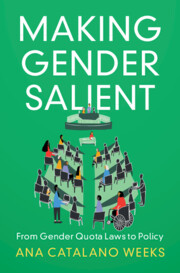Book contents
- Frontmatter
- Dedication
- Contents
- List of Figures
- List of Tables
- Acknowledgments
- 1 Introduction
- 2 When Do Quotas Matter? A Theory of the Substantive Representation of Cross-Cutting Interests
- 3 What Do Women Want? Gender Gaps in Preferences
- 4 The First Stage of Policy Change: The Effects of Quotas on Party Priorities
- 5 The Effects of Gender Quota Laws on Work–Family Policies
- 6 How Gender Quota Laws Change Work–Family Policies
- 7 Conclusion
- Appendix
- References
- Index
3 - What Do Women Want? Gender Gaps in Preferences
Published online by Cambridge University Press: 09 June 2022
- Frontmatter
- Dedication
- Contents
- List of Figures
- List of Tables
- Acknowledgments
- 1 Introduction
- 2 When Do Quotas Matter? A Theory of the Substantive Representation of Cross-Cutting Interests
- 3 What Do Women Want? Gender Gaps in Preferences
- 4 The First Stage of Policy Change: The Effects of Quotas on Party Priorities
- 5 The Effects of Gender Quota Laws on Work–Family Policies
- 6 How Gender Quota Laws Change Work–Family Policies
- 7 Conclusion
- Appendix
- References
- Index
Summary
This chapter offers an inductive approach to defining women’s interests in politics, mapping gender gaps in preferences and where they fall in the left-right political space. Unlike previous studies, which do not define a priori expectations about quotas and policy change in comparative context, this chapter clearly defines expectations about which policies we can expect quotas to change in rich OECD democracies. Using survey data, the chapter explores the size and direction of gender gaps in preferences for a large number of policy issues across countries and over time. While women prefer more spending than men on issues like unemployment, health care, and poverty, no gender gaps emerge on other issues often perceived to be gendered, like education or military spending. The largest gender gaps exist over the issue of maternal employment, where women are more progressive than men by about ten percentage points, and the gender gap has been growing over time. Gender gaps on maternal employment are not explained by partisan ideology. Gender differences persist within political parties, and attitudes towards maternal employment form a distinct underlying response pattern compared to attitudes towards government intervention. Because of this, subsequent book chapters focus on maternal employment and associated work-family policies as key outcomes of interest.
Keywords
- Type
- Chapter
- Information
- Making Gender SalientFrom Gender Quota Laws to Policy, pp. 47 - 68Publisher: Cambridge University PressPrint publication year: 2022

